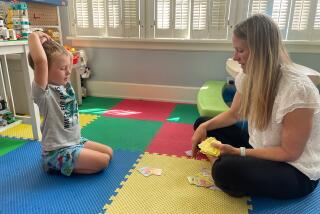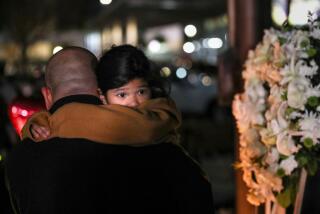Children of Divorce : Family: How kids handle the stress may determine how they fare in the long run. To reduce their anxiety, a new school program teaches coping techniques.
- Share via
In the months after the breakup of her marriage, Joni Pierson sometimes sat down with her seemingly stoic 5-year-old daughter and gently encouraged her to talk about the divorce.
“I think she was afraid to express her feelings in that she was afraid she’d upset me,” said Pierson, of West Los Angeles, whose divorce became final in 1987. “I thought it unusual that she was not having a reaction. I would sit and talk to her and ask her how she felt about it. Her response was, ‘It’s fine. I’m all right.’ I knew it wasn’t OK.”
It’s hardly surprising that children whose parents divorce experience considerable distress at the time of the breakup. Divorce rates have tripled since the 1960s. And despite a recent leveling off in the rate, about 60% of marriages will end in divorce, and 50% of all children will experience their parents’ divorce.
But an eight-year study has shown that how children fare in the long run has less to do with getting through the period immediately surrounding the divorce and more to do with how they deal with the long-term pressures.
Even in stressful situations, children can learn techniques to minimize their anxiety, says JoAnne Pedro-Carroll, a researcher at the University of Rochester, New York, who has long been involved with studying the effects of divorce on children.
Pedro-Carroll is the founder of the Children of Divorce Intervention Program, a school-based program to help children deal with divorce. The program was started when Pedro-Carroll, then a doctoral candidate at the University of Rochester, noticed the profound impact divorce often had on children exhibiting behavior and emotional problems in school. The program, which has spread throughout the nation and several countries, will be introduced in some California school districts this year.
By comparing children of intact homes with children from divorced homes over several years, Pedro-Carroll has been able to identify common problems and behaviors experienced by the children of divorce and devise tactics to help them cope.
The study also has provided valuable information on how parents can help their children adjust to divorce. One of the biggest mistakes parents make is expecting children to recover quickly from their sadness over the divorce, says Linda Alpert-Gillis, a psychologist who works with Pedro-Carroll.
“They want the child to be happy about it too quickly,” she says. “You don’t have to dwell on it, but you have to accept the unhappy feelings for a while.”
The age of the child at the time of divorce makes a big difference in how children respond, says Pedro-Carroll.
Children ages 5 to 8 are more openly sad and may blame themselves for the breakup. The younger children may yearn for the parent who has moved out of the home and may have greater fears of abandonment.
Children ages 9 to 12 are more angry and resentful. Children in this age group may think the divorce wasn’t inevitable, and they often look to blame one parent while siding with the other, Pedro-Carroll says.
Even six years after he and his wife separated, Stan Haymaker says his two children continue to react differently.
His son, 10, has not performed up to his abilities in school and routinely tests the limits of behavior at home, says Haymaker of Culver City.
“As opposed to my son testing everything and everyone . . . my daughter (age 9) is exactly the opposite, which is the way she handles things. She goes out of her way to please everyone.”
But, he says: “Whenever it’s wishbone time with the turkey, he and my daughter both have the same wish. They want mommy and daddy back together again. This is something that has overshadowed their lives.”
Children of all ages “need to know what will happen to them” as a first order of business after the breakup, Alpert-Gillis says. It is a mistake to assume a child is too young to understand, she adds.
In the long run, how children adjust to divorce is shaped by three factors, the study found:
* The parents’ relationships with and expectations of their children.
* A supportive home environment, even in the midst of divorce.
* The extent to which former spouses are able to cooperate and negotiate solutions to the children’s development.
A good parent-child relationship can buffer a child from many effects of divorce, Alpert-Gillis says. For example, the breakup of the marriage should not lead to the breakdown of family rules and routines. Parents should be as consistent about discipline as they were before the divorce. Parents should also schedule time for fun with children.
“In stressful situations, regular bedtimes and mealtimes allow children to feel safe and comfortable,” Alpert-Gillis says. “There is an adult there who can control the situation.”
Joni Pierson says she quickly realized that her children cope best when they followed a schedule, including established visits with each parent.
“When it’s done consistently, they deal with going there much better,” she says of the visitation periods. “But when, at the last minute, plans are changed, they then become uncomfortable about going the next time.”
Children who fare well have an adult in their lives, such as a parent or teacher, who promotes the child’s self-esteem, the study found.
“These resilient kids have someone in their life that makes them feel valuable,” Alpert-Gillis says.
Parents should encourage children to discuss their feelings, as Pierson tried to do with her daughter, Alpert-Gillis adds. Sometimes, it is best for the child to talk to a close family friend or grandparent. Parents should brace for a barrage of negative feelings from the child.
“But it’s important for the parents to acknowledge these feelings rather than to turn away,” she says. “Don’t try to talk a child out of a feeling, such as by buying them something.”
Parents should reassure children, especially younger children, that the divorce is the parents’ problem. Adult problems that often accompany divorce, such as financial difficulties, depression and anger at the ex-spouse, should be kept from the child, she says.
“Let the child be a child,” Alpert-Gillis says. “Don’t put responsibilities on them that they are not ready for.”
Parents commonly make the severe mistake of displaying their rage at the ex-spouse in front of the child, Pedro-Carroll says.
“One of the most serious problems for parents is not being able to encapsulate their own rage and letting it spill over in front of the children,” she says.
Warring parents should avoid criticizing each other or arguing in front of a child, the experts say.
“Keep conflict to yourself and away from your children. Parent conflict can be devastating to kids,” Alpert-Gillis says. “Children want to love both parents even when terrible things happen in the family. It’s a child trait to stand by the parent and love them no matter what.”
For this reason, children are often shattered when drawn into custody battles, Pedro-Carroll says. A recent California study confirmed children have more problems adjusting when joint custody is imposed on warring parties.
“What the children say is how awful it is for parents to be in protracted litigation,” Pedro-Carroll says. “We hear children say, ‘Please spare us the gory details.’ They don’t want to hear about that.”
TIPS FOR PARENTS * Understand the impact of divorce on children.
* Prepare your children for the changes involved in divorce.
* Accept children’s feelings and encourage them to express their feelings in constructive ways.
* Reassure your children.
* Allow your child to continue to be a child.
* Give children permission to love both parents.
* Solve problems together.
* Work on your relationship with your children.
* Keep the conflict to yourselves.
* Maintain as much structure and predictability as possible in your daily routine.
* Listen to children’s verbal and nonverbal communication.
* Take care of yourself.
Source: The Children of Divorce Intervention Program
Times staff writer Bettijane Levine contributed to this story.


